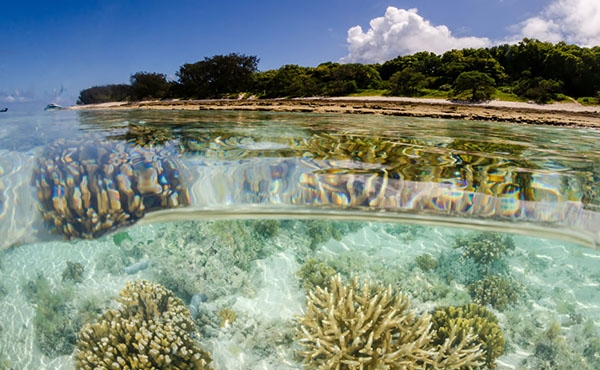The Reef and adjacent Catchment are a linked system with high internal and external connectivity.36,838,919 This biophysical connectivity within and between land, freshwater and marine ecosystems is pivotal to the health and functioning of the Region’s ecosystems. Connectivity is provided in various ways, for example, through water flows from the catchment to sea, flooded landscapes,364 genetics,920 species migration,919 and downstream transport of sediments that nourish beaches and mangrove forests.36,123,838
Larger animals, such as fish and sharks, actively move between connected habitats for reproduction and foraging,364,921 while prevailing water currents are important for connectivity in planktonic organisms 838 and between islands. Marine herbivores can help to connect seagrass habitats, while seabirds play an important role in dispersal of island vegetation. For species with significant connections outside the Region, such as shorebirds (Section 2.4.13) and humpback whales (Section 2.4.14), the condition of distant habitats can directly affect populations in the Region. Connectivity is also a vital consideration in the movement of diseases 922 and parasites 923 into and across the Region.
Connectivity is influenced by many spatial and temporal events and processes and may be interrupted by natural and anthropogenic drivers.838 For example, most Catchment development (Section 6.4) has occurred in low-lying coastal floodplain areas, leading to losses in connectivity through hydraulic barriers, excessive aquatic plant growth or establishment of invasive species.36,924 Shifts in the types of sediment delivered from the Catchment can have radical downstream impacts (Section 6.5.2).
Connectivity between coral reefs and other habitats across the Region supports the maintenance of genetic diversity within and between populations, a critical factor in the ability of species’ to adapt to environmental change.29 The influence of connectivity on the resilience and adaptation potential of coral populations is an important area of current research interest.925 New techniques, particularly genetic analysis (Box 2.1), are providing evidence of population connectivity and breaks in connectivity that indicate genetic separation and could have evolutionary consequences.838,926 For example, genetic studies on corals have confirmed expectations from connectivity models, showing predominant north-to-south gene flow over the recent evolutionary past.926


